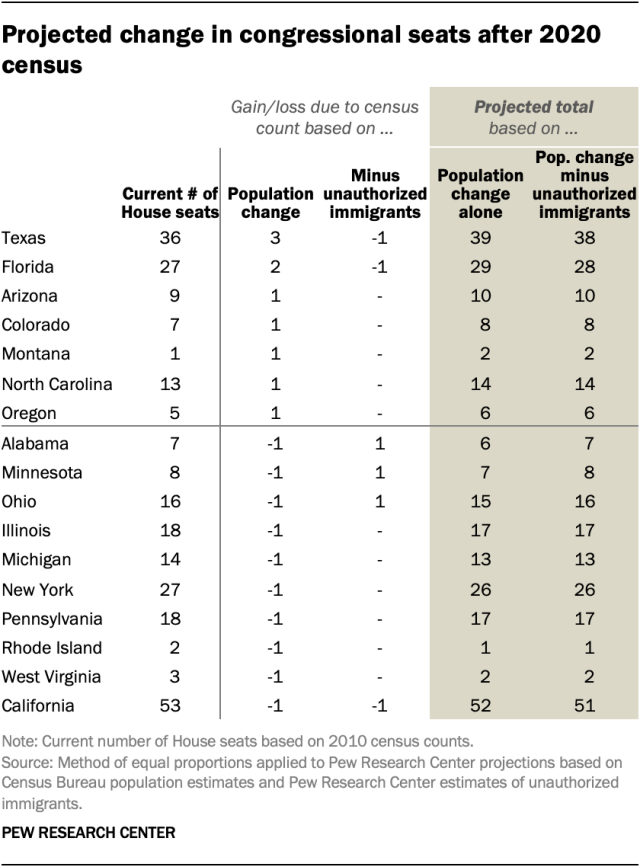Seats in the House of Representatives Are Apportioned Based on

Since the beginning demography of the United States in 1790, counts that include both citizens and noncitizens have been used to apportion seats in the House of Representatives, with states gaining or losing based on population change over the previous decade. If unauthorized immigrants in the U.South. were removed from the 2022 census apportionment count – which the White House seeks to do – iii states could each lose a seat they otherwise would have had and iii others each could gain ane, according to a Pew Inquiry Heart analysis based on government records.
If unauthorized immigrants were excluded from the apportionment count, California, Florida and Texas would each stop up with one less congressional seat than they would have been awarded based on population alter lone. California would lose two seats instead of one, Florida would proceeds i instead of ii, and Texas would gain two instead of 3, according to analysis based on projections of Census Bureau 2022 population estimates and the Center's estimates of the unauthorized immigrant population.
This web log mail explores the office of the nation's unauthorized immigrant population in apportionment of congressional seats. Every decade, the U.S. Census Bureau conducts a count of all people living in the country, which is then used to distribute seats in the House of Representatives to the states. The analysis in this blog postal service is based on projections using Census Bureau population estimates, Pew Inquiry Center estimates of the size of the unauthorized immigrant population and established formulas for assigning congressional seats.
The Method of Equal Proportions assigns congressional seats to states based on their populations later on each state is given their start seat. The method requires fifty state population figures and assigns seats sequentially; it stops after the 435th seat is assigned. Our population figures for 2022 are based on the Census Agency's official population estimates for 2022 and 2022 projected to April 1, 2020. We use these for our baseline apportionment.
The Pew Research Center has published estimates of the unauthorized immigrant population for states through 2017. The estimates for 2022 and 2022 show very niggling change, and external indications suggest few changes since and then. Accordingly, we use our 2022 estimates for 2022 and subtract them from the total to provide the populations for an apportionment which excludes unauthorized immigrants.

Alabama, Minnesota and Ohio would each hold onto a seat that they would accept lost if apportionment were based merely on total population modify. Alabama filed a lawsuit in 2022 seeking to block the Demography Bureau from including unauthorized immigrants in its population count.
In add-on to these states, 11 more would gain or lose seats based on population alter alone, whether unauthorized immigrants are included or excluded. 5 states would gain one seat each: Arizona, Colorado, Montana, North Carolina and Oregon. Six states would lose one seat each: Illinois, Michigan, New York, Pennsylvania, Rhode Isle and West Virginia.
The apportionment of seats in Congress is required by the U.S. Constitution, which says that the census will be used to divide the House of Representatives "among the several States co-ordinate to their corresponding numbers, counting the whole number of persons in each Country," except for enslaved people, who, until the late 1800s, were counted as 3-fifths of a person, and certain American Indians. The 14th Amendment eliminated the partial count of enslaved people, and the total American Indian population was added later to congressional reapportionment calculations. The number of seats in the Business firm was fixed at 435 following the 1910 census. Each state gets one seat, and the residuum are assigned according to a circuitous formula based on relative population size.
The census count includes everyone living in the U.s., except for strange tourists and business concern travelers in the country temporarily, co-ordinate to Census Agency rules. For circulation purposes since 1990, military and civilian federal employees stationed abroad and their dependents are counted as living in a land if they provided a state address in their employment records. The District of Columbia, Puerto Rico and U.S. Isle area populations are excluded from the apportionment full because they have no voting representation in Congress.
Federal law requires the population totals from the decennial census exist delivered to the president nine months after Census Day, meaning Dec. 31, 2020. The Demography Agency has requested Congress extend the deadline to April 30, 2021, due to the coronavirus pandemic, although the White House reportedly may push for a "timely census" fueled by $i billion in boosted funding. States would redraw congressional district boundaries to fit the new totals. The results would accept issue for the Congress that meets in 2023.
In his memorandum announcing a new policy "to the extent practicable" in how congressional seats are divided up, President Donald Trump asserted that the president has discretion to decide who is considered an inhabitant of the U.South. for apportionment purposes. Some of the same groups that successfully challenged the White House attempt to add a citizenship question to the census last yr said they also would sue to block any modify in apportionment policy. Democrats announced they would hold an emergency congressional hearing to respond.
The Demography Bureau does non regularly publish counts or estimates of unauthorized immigrants, although the Department of Homeland Security has done so. Concluding yr, afterward the U.S. Supreme Courtroom ruled against including a question about citizenship on the 2022 census, the president ordered the Census Bureau to assemble a separate database, using other authorities records, on the citizenship status of every U.S. resident. This has also been challenged in court.
The Middle's analysis relies on assumptions most populations to be counted in the 2022 census and estimates of unauthorized immigrants. The actual figures used for circulation volition exist dissimilar from these, and so the actual circulation could differ regardless of whether unauthorized immigrants are excluded from the apportionment totals.


D'Vera Cohn is a senior writer/editor focusing on clearing and demographics at Pew Research Center.
Source: https://www.pewresearch.org/fact-tank/2020/07/24/how-removing-unauthorized-immigrants-from-census-statistics-could-affect-house-reapportionment/
0 Response to "Seats in the House of Representatives Are Apportioned Based on"
Post a Comment